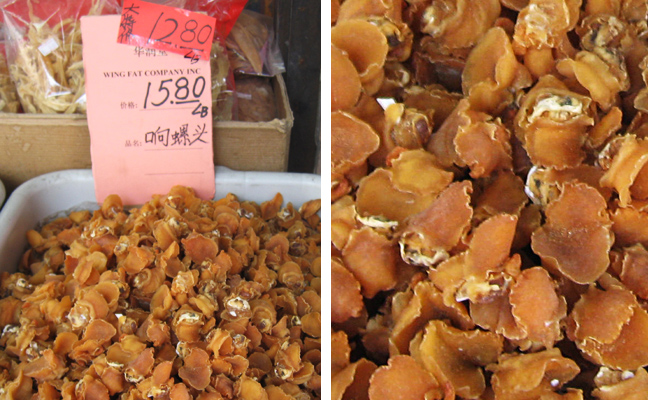Chinatown Mystery #9
By Dyske May 6th, 2009

How about this one? I’m pretty sure this is some type of shellfish (could be a type of mushroom too) but what kind, and how do you use it? Anyone?
By Dyske May 6th, 2009

How about this one? I’m pretty sure this is some type of shellfish (could be a type of mushroom too) but what kind, and how do you use it? Anyone?
Frank Luo says:
May 7th, 2009 at 12:45 amThe cardboard in the box says conch heads. I have had conch before but have never tried to make it myself. They seem to be popular in Cantonese seafood cuisine, and I see them quite often at Cantonese banquets.
There are many recipes on the web, but the vast majority are for fresh conch. The only recipe I saw that specifically called for dried conch is conch heads stewed together with chicken feet and ribs, flavored with goji berries and other Chinese herbs. The chicken feet, which are all bone, skin, and tendon, add gelatin and texture, the ribs add a deep, rich flavor from the bones, all of which combine with the conch and the herb seasonings to create a melange of flavors that exemplifies the wide spectrum of complex flavors, exceedingly well balanced and harmonized, that Cantonese cuisine does so well.
Other than stewing, stir-frying is also popular. For stir-frying, you would first parboil them — from what I remember when I ate these things at banquets, the meat is very firm with a nice snap to the bite, what the Chinese call 脆 cui, literally “crunchy” in texture, and I suppose this means cooking them through in the wok would end up making them too hard — then remove bits and pieces that won’t taste good, including the tough outer skin and some other protruding bits, then slice it up and stir fry it with other ingredients.
A sub-category of stewing, the 原盅 Yuanzhong, literally “in the original bowl” method also seems quite popular. You would start with a small bowl that is deeper than usual, often taller than it is wide, place the conch head, some ginger, pre-boiled lean pork, clear chicken broth, rice wine, and seasonings in the bowl, then cover it and steam the whole thing for an hour and a half. This method keeps all the flavors within the bowl, resulting in absolutely delicious broths.
ftfly says:
May 12th, 2009 at 8:46 amthere is a lot of dish cooked by dried seafood, actually that is consider to be more tasty than fresh one. but actually the oringinal reason that we made dried seafood was because we do not have fridge at that time. haha.
normally, dried seafood is for soup.
and about stir frying, there are a bunches of way about stir flying, some asked to be soft and juicy, some are asked to be half wet,
and crunchy is something for deep frieds stuff. not for pan frying, the meat should be still soft and juicy, the cover should be a little hard, and crunchy. or both of them get dry and crunchy.
i am sorry to say so, but looks i realized that in a different way with u
原盅 is anothign thing that just common, just means the original soup cooked with the meat, that is part of our food, is consider to be the best of the whole dish. and of course, not every 原盅 has the same recipe. rice wine is for southern chinese, in north would use some other wine .
btw, southern chinese food is more sweet, and northern chinese food is more salty, but obviously, not salty enough for my bf yet. ahaha, if you could read this, let me know, ahaha. soon, you would eat enough salt and turn to be a dried seafood. must be pretty delicioius, but the best is you are big. ahahaha.